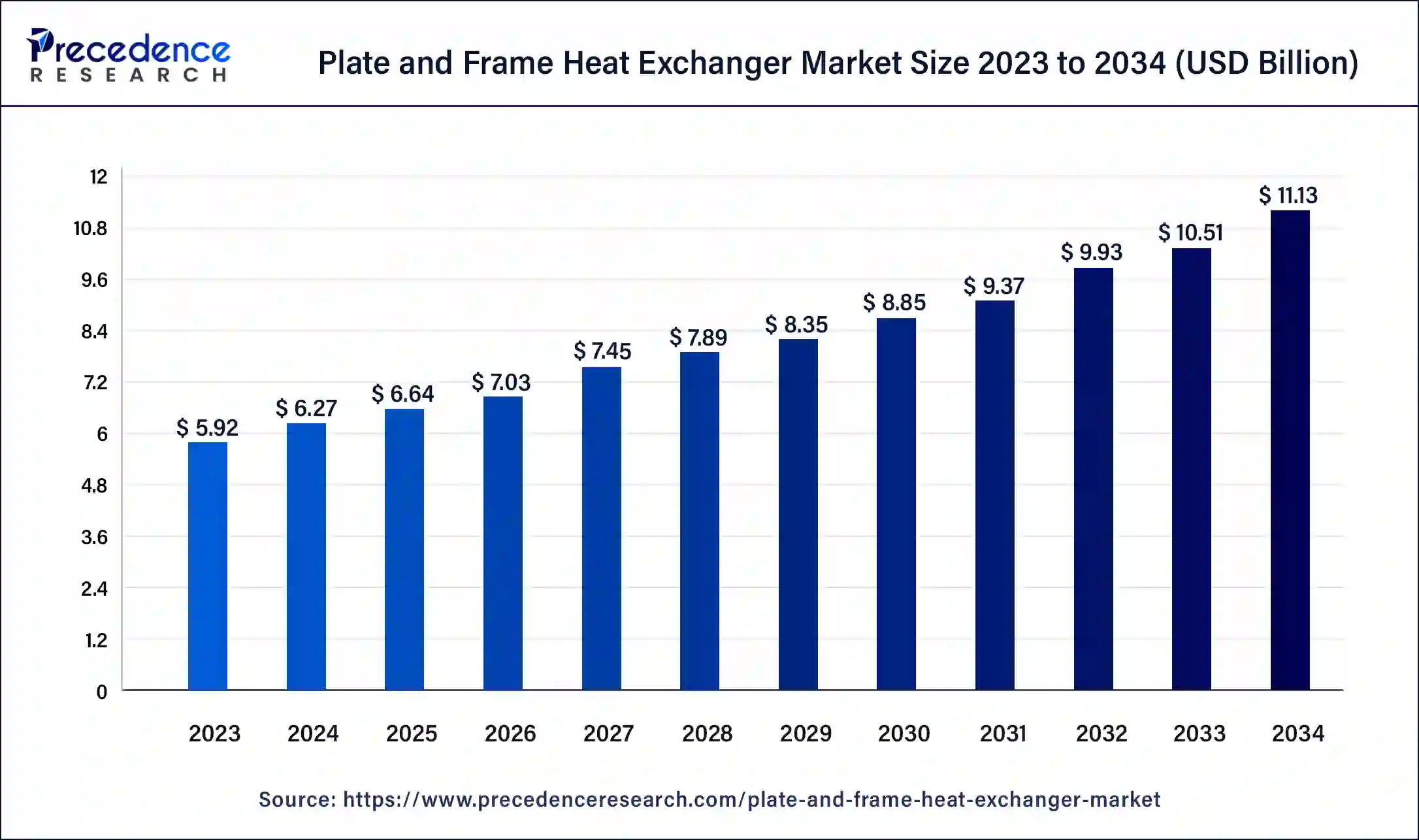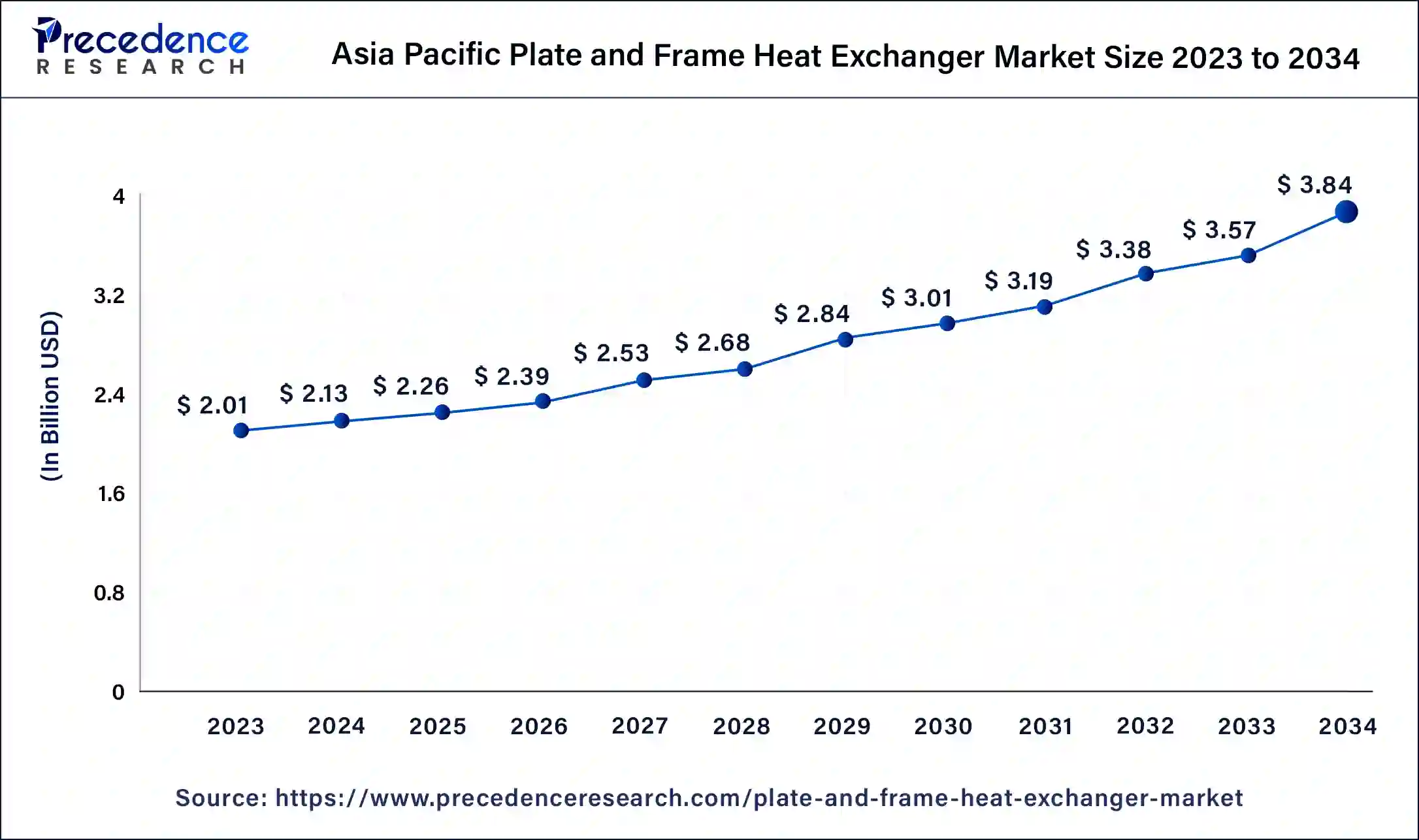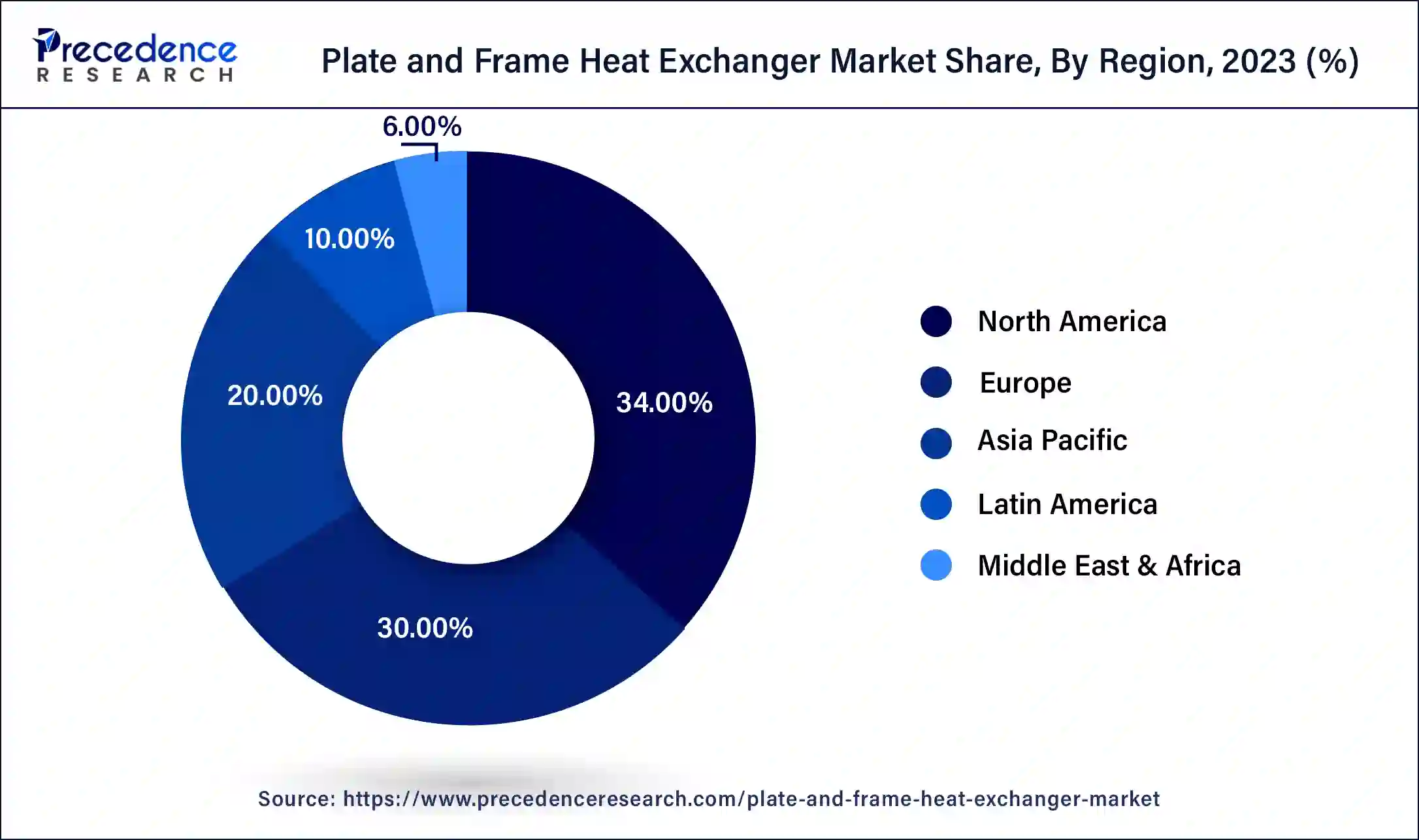February 2025
The global plate and frame heat exchanger market size was USD 5.92 billion in 2023, calculated at USD 6.27 billion in 2024 and is expected to be worth around USD 11.13 billion by 2034. The market is slated to expand at 5.91% CAGR from 2024 to 2034.
The global plate and frame heat exchanger market size is worth around USD 6.27 billion in 2024 and is anticipated to reach around USD 11.13 billion by 2034, growing at a CAGR of 5.91% over the forecast period 2024 to 2034. The plate and frame heat exchanger market growth is attributed to the increasing demand for energy-efficient solutions and the adoption of advanced heat transfer technologies across various industries.

The Asia Pacific plate and frame heat exchanger market size was exhibited at USD 2.01 billion in 2023 and is projected to be worth around USD 3.84 billion by 2034, poised to grow at a CAGR of 6.06% from 2024 to 2034.

Asia Pacific dominated the plate and frame heat exchanger market in 2023, owing to the increased industrial growth rate and urbanization of countries, including China, India, and Japan. The upward trend in manufacturing industries and infrastructure development projects provides enormous opportunities for plate and frame heat exchangers. Additionally, the food and beverage industry in this segment is projected to fuel high growth since these systems are a must-have for numerous processing functions.

North America is projected to host the fastest-growing plate and frame heat exchanger market in the coming years due to the existing complex industrial that deals with consuming energy-efficient products. The growth of the manufacturing industry and rising investment in HVAC and refrigerator technologies mainly propels the market for heat exchangers in the region. Macro pressure toward the decrease of greenhouse gases has had the effect of prioritizing the industry in the adoption of energy-saving technologies. Moreover, organizations are focusing on becoming environmentally friendly and meeting high regulatory standards.
Rising energy consciousness among industries leads to the growth of the plate and frame heat exchanger market. This technology employs a frame containing a number of thin plates by which heat is transferred from one fluid to another, but without allowing the two fluids to mix. Through improving thermal efficiency, the plate and frame heat exchangers benefit industries by saving energy and operation costs, thus suited for HVAC, chemical, food and beverages, and power industries.
Sustaining the plate and frame heat exchanger market has stretched to advanced materials and innovative designs, which add up to efficiency and reliability points. Rising awareness of conserving energy among global industries means that this product is anticipated to witness steady growth, as its utilization helps to reduce the concern regarding the environment.
Impact of Artificial Intelligence (AI) on Plate and Frame Heat Exchanger Market
Artificial Intelligence is enhancing the plate and frame heat exchanger market by enhancing design methodologies, enhancing the functionality of heat exchangers, and facilitating the maintenance of heat exchangers. AI helps to process large numbers of datasets and reveal patterns that enhance heat exchanger designs, minimize energy usage, and decrease production costs. Furthermore, the use of AI in monitoring systems in real-time reduces potential problems that lead to expensive failures. It is expected that AI’s contribution towards streamlining these processes facilitates innovation and improvements to efficiency within the sector in the coming years.
| Report Coverage | Details |
| Market Size by 2034 | USD 11.13 Billion |
| Market Size in 2024 | USD 6.27 Billion |
| Market Growth Rate from 2024 to 2034 | CAGR of 5.91% |
| Largest Market | Asia Pacific |
| Base Year | 2023 |
| Forecast Period | 2024 to 2034 |
| Segments Covered | Type, Application, and Regions |
| Regions Covered | North America, Europe, Asia-Pacific, Latin America and Middle East & Africa |
Increasing demand for energy-efficient solutions
Growing emphasis on energy efficiency across industries is anticipated to drive the adoption of the plate and frame heat exchanger market. Such devices enhance heat transfer and reduce heat loss and thus are widely used in several domains such as heating, ventilation, air conditioning, chemical processing, and power plants. This is achieved by improving heat transfer and minimizing energy consumption, which is made achievable by plate and frame heat exchangers. There is an increasing demand for energy savings that is expected to boost the demand in industries focusing on sustainability and operations, thus making plate and frame heat exchangers important to conserve energy.
| Year | Global Energy Demand Growth (%) | Investment in Energy Efficiency (USD billion) | CO2 Emissions Reduction from Energy Efficiency (million tonnes) |
| 2020 | 1.5% | 300 | 500 |
| 2025 | 2.0% | 400 | 700 |
| 2030 | 2.3% | 500 | 950 |
| 2040 | 2.8% | 650 | 1200 |
Restrain maintenance and operational complexities
Maintenance challenges are expected to impede the adoption of the plate and frame heat exchanger market in certain industries. The fouling and corrosion of these systems require constant cleaning, especially when dealing with fluids containing suspended solids or chemicals. Unevenness arising from operational requirements in terms of skills, tools, and time suffice to push up the total costs within the system lifecycle. Additionally, the rising complexities in manufacturing processes in industries cause routine maintenance regimens, which are an added challenge to overall operations.
Rising technological advancements
Rising technological advancements in heat exchanger design and materials are expected to create immense opportunities for the players competing in the plate and frame heat exchanger market. Due to the advancements in technologies, manufacturers design systems with high thermal efficiency, high fouling factors, and lightweight for installation. Additionally, continued development in the digital twin technology provides a real-time health check and prognosis for the potential of the asset, guaranteeing maximum efficiency and minimum downtime.
Sub-technologies, such as additive manufacturing or 3D printing and CFD modeling, provide the ability to design products based on the needs of the market. These developments enhance the level of economy and also extend the areas of use of the plate and frame heat exchangers, promoting new entrants into the plate and frame heat exchanger market and the growth of competitiveness. This extreme emphasis on technology increases the marketability of plate and frame heat exchangers in companies seeking sustainability and efficiency.
The gasket segment held a dominant presence in the plate and frame heat exchanger market in 2023 due to their usefulness in numerous operations and processes, creating great demand for these tools. These systems offer good thermal characteristics and versatility and are an excellent fit for the food and beverage, heating and cooling, and chemical sectors. The gasket designs are also compatible and easily repairable, and this is ideal for use in industries where regular cleaning is necessary to avoid fouling. Companies are becoming increasingly conscious of power and energy conservation in industrial processes, which is driving the widespread use of gasket systems.
The brazed segment is expected to grow at the fastest rate in the plate and frame heat exchanger market during the forecast period of 2024 to 2034. These exchangers provide a durable mechanism, especially for instances that demand high pressure and high temperatures, hence suitable for use in refrigeration systems, air conditioning, industrial heating, and cooling. Developments of modern techniques in brazing have improved the efficiency and strength of these heat exchangers, making them attractive. These brazed plate heat exchangers are more efficient than other heat exchangers while occupying less space. Additionally, the ready market for compact and lightweight systems in the automotive and aerospace sectors is fuelling the brazed segment.
The HVAC & refrigeration segment accounted for a considerable share of the plate and frame heat exchanger market in 2023, due to the growing demand for proper climate control techniques. The changes in temperature around the globe and the variability of weather have led to an increased need for efficient heating and cooling in homes, offices, and industries. Plate and frame heat exchangers have good thermal performance and thus low energy losses and operating costs. Furthermore, the increasing concern towards environment-friendly and innovatory green building concepts increases the need for energy operating technologies, including plate and frame heat exchange.
The food & beverages segment is anticipated to grow with the highest CAGR in the plate and frame heat exchanger market during the studied years. Combining beneficial pasteurization, heating, and cooling processes, plate and frame heat exchangers guarantee the safety and quality of the products. There is a steady increase in demand for high-efficiency heat exchangers in the food processing industry, as these industries consider power utility and wastage to be significant factors in their production processes. Furthermore, the drift towards the procurement of environmentally friendly methods in food processing correlates well with the benefits associated with plate and frame heat exchangers.
Segments Covered in the Report
By Type
By Application
By Geography
For inquiries regarding discounts, bulk purchases, or customization requests, please contact us at sales@precedenceresearch.com
No cookie-cutter, only authentic analysis – take the 1st step to become a Precedence Research client
February 2025
February 2025
December 2024